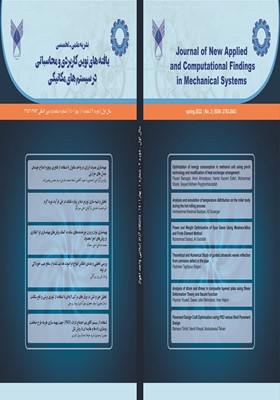تحلیل و شبیه سازی توزیع دما بر پیکره غلتک در طی فرآیند نورد گرم
محورهای موضوعی : یافته های نوین کاربردی و محاسباتی در سیستم های مکانیکی
امیرحشمت خدمتی بازکیائی
1
![]() ,
علی سوزنگر
2
,
علی سوزنگر
2
1 - گروه مهندسی مکانیک، واحد سوسنگرد، دانشگاه آزاد اسلامی، سوسنگرد، ایران
2 - مهندس مکانیک، مهندس تعمیرات گروه ملی صنعتی فولاد ایران، اهواز، ایران.
کلید واژه: اجزاء محدود, فرآیند نورد, توزیع حرارت,
چکیده مقاله :
صنعت نورد، متداولترین و پر رونق ترین روش تولید فرآورده های فلزی است. نخستین هدف فرآیند نورد، کاهش سطح مقطع و یا ضخامت قطعه کار است، این عمل به دو صورت نورد گرم و سرد انجام می پذیرد، فلز از بین دو غلتک عبور نموده تا شکل شیار ( کالیبر ) غلتک را بگیرد، بدین جهت غلتکهای نورد اجزاء مهمی در کارخانجات نوردی میباشند. هدف از انجام این پژوهش تحلیل انتقال حرارت در شرایط کارکرد نورد گرم و یافتن توزیع حرارت در غلتکهای نورد با استفاده از شبیه سازی اجزاء محدود میباشد، شبیه سازی به صورت غیر خطی بوده و فرض گردیده که غلتک همگن، همسانگرد، بدون ترک و کرنش حرارتی و دمای محیط برابر دمای اتاق در نظر گرفته شده است. توزیع حرارت در غلتک در این پژوهش به دو صورت با استفاده از سیستم خنککاری پاششی و بدون استفاده از این سیستم بدست آمده و پس از آن نتایج بدست آمده از شبیه سازی اجزاء محدود را با دادههای آزمایشگاهی استخراج شده، مورد صحت سنجی قرار گرفته شده است که بالاترین میزان درصد خطای نسبی در پیشبینی 08/334 درصد بوده که بیانگر تطبیق نتاایج حاصله از حل عددی با داده استخراجی بوده است.
The rolling industry is the most common and prosperous method of producing metal products. The first goal of the rolling process is to reduce the cross-sectional area or the thickness of the workpiece, this process is done in two ways, hot and cold rolling, the metal passes between two rollers to take the shape of the groove (calibre) of the roller, so the rolling rollers of the components They are essential in climbing factories. This research aims to analyze heat transfer in hot rolling conditions and find the heat distribution in rolling rollers using the finite element method. The simulation is non-linear and assumes that the roller is homogeneous, isotropic, and without cracks and thermal strain. And the ambient temperature is considered negligible. The heat distribution in the roller in this research has been obtained in two ways using the spray cooling system and without using this system, and then the results obtained from the finite element simulation have been verified with the extracted experiment data, The highest percentage of relative error in prediction was 08.334%, which indicated the matching of the results obtained from the numerical solution with the extracted data.
مراجع
[1] صابونچی، ا.، عباسپور، م.، گنجهزاده، ا.، (1379)، حل عددی معادلات انتقال حرارت غلتک نورد در حالت غیردائم و شرابط مرزی متغیر، سمپوزیوم فولاد 79، ص. 657-668.
[2] حاجیاننژاد، ع.، توانگر، م.، گنجهزاده، ا.، (1379)، شبیهسازی کامپیوتری تغییرات دمای بار در خز نوردگرم ورق، سمپوزیوم فولاد 79، ص. 295-307.
[3] صابونچی، ا.، خردمند، س.، مدرس، ف. ق.، کییگانه، ع.، (1384)، شبیهسازی حرارتی غلتکهای نورد گرم بمنظور تخمین اثرات تغییر جنس غلتک بر توزیع دما و کراون حرارتی غلتک کاری، سمپوزیوم فولاد 84، ص. 322-332.
[4] Forouzan, S., Akbarzadeh, A., (2007), Prediction of effect of thermo-mechanical parameters on mechanical properties and anisotropy of aluminum alloy AA3004 using artificial neural network, Materials and Design (28), pp 1678–1684.
[5] سنبلی، ع.، سراجزاده، س.، (1386)، تعیین تنشهای حرارتی-مکانیکی در غلتک طی فرآیند نورد داغ ورق، سمپوزیوم فولاد 86، ص. 521-528.
[6] قرهداغی، س.، کرمانپور، ا.، ضیاییراد، س.، حسنپور، ک.، ذاکر، م.، (1386)، شبیهسازی عددی مکانیکی-حرارتی مرحله خشن کاری نورد کیلگرد کارخانه کوثر ، سمپوزیوم فولاد 86، ص. 773-781.
[7] کرمانپور، ا.، ضیائیراد، س.، حسنپور، ک.، طرقینژاد، م.ر.، قرهداغی، س.، ذاکر،م.، (1387)، تحلیل خط نورد میلگرد فولادهای ساختمانی کارخانه کوثر توسط شبیهسازی عددی، سمپوزیوم فولاد 87، ص. 841-848.
[8] Yang, H., Wang, M., Guo, L. G., Sun, Z. C., (2008), 3D coupled thermo-mechanical FE modeling of blank size effects on the uniformity of strain and temperature distributions during hot rolling of titanium alloy large rings, Computational Materials Science 44(2), pp 611-621.
[9] باستی، ع.، خلیلیراد، ا.، سندی، م. ج.، (1388)، بررسی اثرات پارامترهای فرآیند نورد گرم در محصول نهایی به روش اجزای محدود، دهمین کنفرانس مهندسی ساخت و تولید ایران، 10.
[10] Shahani, A.R., Setayeshi, S., Nodamaie, S.A., Asadi, M.A., Rezaie, S., (2009), Prediction of influence parameters on the hot rolling process using finite element method and neural network, Journal of Materials Processing Technology 209(4), pp 1920-1935.
[11] D. Benasciuttia, D., Brusab, E., Bazzaro, G., (2010), Finite elements prediction of thermal stresses in work roll of hot rolling mills, Procedia Engineering 2(1), pp 707-716.
[12] Rui-bin, M., Chnag-sheng, L., Xiang-hua, L., Bin. H., (2010), Analysis of strip temperature in hot rolling process by finite element method, International Journal of Iron and Steel Research 17(2), pp 17-21.
[13] Hsu, Y., Lin, Y., Sun, K., Wu, S., (2012), Development of a Continuous Rolling Process for Titanium Wires, China Steel Technical Report 25(1), pp 28-35.
[14] Ding, Y., Zhu, Q., Le, Q., Zhang, Zh., Bao, L., Cui, J., (2015), Analysis of temperature distribution in the hot plate rolling of Mg alloy by experiment and finite element method, Journal of Materials Processing Technology 225, pp 286-294.
[15] Chen, J., Dong, F., Jiang, H., Liu, Zh., Wang, G., (2018), Influence of final rolling temperature on microstructure and mechanical properties in a hot-rolled TWIP steel for cryogenic application, Materials Science & Engineering A 724(1), pp 330-334.
[16] Bazkiaei, A.K., Shirazi, K. H., Shishesaz, M., (2021), Thermo-hyper-viscoelastic analysis of a rubber cylinder under cyclic deformation, Journal of Rubber Research 24(1), pp 13-26.
[17] آزاد، م.، (1389)، آشنایی با نورد فلزات، اداره آموزش و توسعه منابع انسانی شرکت گروه ملی صنعتی فولاد ایران.
_||_

